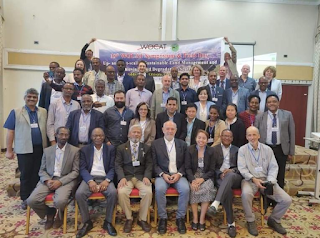Sustainable Land Management and Ethiopia Strategic Investment Framework
Monday, April 29, 2013
ESIF-SLM
ESIF-SLM was developed as an umbrella framework for all land management on the basis of 1.Paris declaration of aid effectiveness and 2. Collaboration of international and national stakeholders (Terrafrica, FAO, GM, WB, GIZ and government ministries) The Ministry of Agriculture lead the process and coordinating its implementation where all actors and partners in land management, align and harmonize efforts, approaches and technologies. http://www.moa-redfs.gov.et/node/10
ESIF-SLM was developed as an umbrella framework for all land management on the basis of 1.Paris declaration of aid effectiveness and 2. Collaboration of international and national stakeholders (Terrafrica, FAO, GM, WB, GIZ and government ministries) The Ministry of Agriculture lead the process and coordinating its implementation where all actors and partners in land management, align and harmonize efforts, approaches and technologies. http://www.moa-redfs.gov.et/node/10
National framework for SLM
The Government of Ethiopia has developed a ‘country-wide’ programmatic framework for SLM, and has taken important steps in this direction. The Framework sets the key priorities for SLM investments in the country (in both food secure and food insecure areas); describes the strategy to scale-up SLM (i.e. key objectives, outcomes, activities and indicators), and define the approach and mechanisms for coordination, consultation, participation and P, M&E.
Objectives of the SLMP
To scale up best management practices in sustainable land management practices and technologies for smallholder farmers in the “high potential” (“food secure”) areas that are increasingly becoming vulnerable to land degradation and food insecurity; And to expand the coverage and enhance the Government’s land certification program, with the aim of strengthening land tenure security for small holder farmers.
German
International Cooperation (GIZ) GmbH
German
TC Contribution To the Sustainable Land Management Program of Ethiopia
The German TC contributes to the
capacity development of actors relevant for the upscaling
of the national Program for
Sustainable Land Management. This is realized by complementing the
financial contributions of the KfW and the World Bank. For this purpose,the
project supports existing partner structures instead of establishing its own.
In order to systematically and sustainably address identified capacity
gaps, the TC develops a capacity development strategy and implements it together
with its partner.http://www.giz.de/themen/en/14260.htm
The TC delivers demand-oriented
advisory services at the macro and meso levels. Training for multiplicators, especially at the meso level, initiate a cascading capacity
development process which unfolds results with the target group at the
micro level. To avoid delays from this process for implementing FC
investments, the TC delivers direct training services for the agricultural
extension experts at the Woreda level for a transitional period. Coaching
of the partner structure’s experts and multiplicators on applying the newly
acquired competencies is systematically linked to the training's with a
view to ensure quality and sustainability of the TC efforts. For conveying
messages, the project is building on the experiences of the previous
program (Program for Sustainable Utilization of Natural Resources – SUN)
and the first program phase. The experiences are consolidated and further developed with
the intention to promote up scaling.
Re greening Ethiopian Highland, Sustainable Land Management program in Ethiopia
Pictures below illustrate restoration of the natural resource base of our environment
Re greening Ethiopian Highland, Sustainable Land Management program in Ethiopia
Pictures below illustrate restoration of the natural resource base of our environment
Obtained
vegetation cover change as a result of the rehabilitation work.
Source:
Program for Sustainable Utilization of Natural Resource in Ethiopia


Comments
Post a Comment